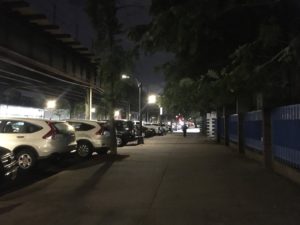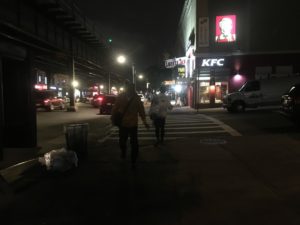The inhibited Latino teenager was in the 10th grade in IN-Tech Academy (MS/High School 368) in Marble Hill when teachers began wondering if he should receive some additional help. Quiet, withdrawn, the young boy was having trouble connecting with other friends, and with his school work.
Most mental health cases are first noticed by teachers and guidance counselors when the children are acting out, in obvious, disruptive ways. But quiet depression like his is often overlooked. Pedro (his real name is being withheld to protect his privacy) was able to receive help because his school had a special school-based mental health clinic, said Arlene Klingman, the clinical director of school-based services at Mosaic Mental Health.
Formerly known as Riverdale Mental Health Association, Mosaic has provided mental health services for residents ever since it was founded in 1959. It has been running school-based mental health clinics since 2007 when the New York State Office of Mental Health launched a program inviting agencies to apply to be providers in schools.
School mental health services have increased nationwide in the last decade, according to the federal Centers for Disease Control (School Health Policies and Practices Study 2016). School-based mental health clinics like the one at IN-Tech are one of seven types of alternative mental health programs in schools, licensed by state mental hygiene law.
Currently 65 of the 432 district and charter schools in the Bronx have school-based mental health clinics. Mosaic is present in two of those, and plans to expand.
Clinicians provide individual, group or family therapy in a regular basis at the school, as well as psychiatric evaluations and medication management. These clinics operate in rooms provided by the school. Mosaic decorates them in a therapy-room style, allowing clinicians to work with children in their natural environment and holding close dialogue with school staff.
The atmosphere worked well for a student like Pedro, who was withdrawn and anxious. “He basically had no friends, didn’t socialize,” said Klingman. “He didn’t particularly want to have friends, but it’s not like he was happy being on his own either.” Mosaic’s clinicians didn’t believe he had a low level of Asperger’s Syndrome and instead diagnosed him with social anxiety.
“Besides having access to the real world of the student, you also have access to the guidance counselors and the teachers,” said Klingman. “You get very valuable information from them, as well about how the student is functioning in school.”
Early intervention for children with mental illness is critical, making school-based clinics an essential part of treatment. Fifty percent of children with mental illness show signs of troubling behavior before age 14. Three-quarters before age 24, according to the American Psychiatric Association. Addressing mental disorders early can help reduce the severity of the issue according to the association.
Mental illness can have lasting consequences. Suicide is the second leading cause of death in individuals aged 15 to 24 years-old country and state wise, according to the Centers for Disease Control and Prevention, a branch of US Department of Health and Sanitation.
The overall rate of suicide has been increasing over the past decade. There are 25 non-fatal attempts for every death, according to CDC. The 2017 Youth Risk Behavior Survey reported one in six high school students had seriously considered attempting suicide in the previous year.
One-third of high school students reported feeling sad or hopeless for several consecutive days. The same percentage said they had stopped doing normal activities for two or more weeks at a time in the past year, according to the survey.
By having the clinics inside the school, children are more likely to seek services, benefiting from treatment and ultimately achieving better academic performance and higher self-esteem.
Besides the clinic at IN-Tech, Mosaic operates a clinic at Yalow Elementary School, which treats children as early as Kindergarten. At Yalow, a family support program is also in place. “The main idea behind that program is mostly engaging the family, having them come on board to our philosophy and our way of thinking,” said Mayra Estrada, deputy executive director at Mosaic. “We want our kids to be good in school, and the only way they can be good is if parent and child have a pretty good and sober relationship.”
Problems vary widely according to how old the children are. In elementary school, children need to learn how to regulate their emotions. Children often behave in immature ways, much like toddlers, instead of five-year-olds. “A lot of these children have issues at home that are putting pressure on them,” said Klingman. “The whole family is having trouble adjusting.” Some cases include domestic violence, incarcerated parents, immigrant families dealing with an unfamiliar culture, and all of those impact the children.
Issues get more complex as the children get older. In Middle School attention problems, disruptive behavior, and bullying are predominant. “With puberty, you start seeing all of this social stuff just exploding,” said Klingman.
Fighting erupts and sexual acting out may happen, together with more critical issues such as drug use and gang-like activity. Most of these problems tend to follow children through High School.
Children’s connections to teachers and counselors in a collaborative atmosphere is key, Klingman said. Cases tend to be diagnosed more efficiently and effectively than if they had to go through a bureaucratic process.
Once a student is referred to the clinic, Mosaic assesses the whole child. “You can’t really work with a child without understanding the family situation,” said Klingman.
Mosaic currently treats 16 to 18 students every year in each school, in what adds to a total of about 300 sessions. Twice as many students are referred, but only half show up. The duration of a patient’s treatment also varies widely, according to Klingman, but the average is one school year.
In Pedro’s case, it lasted a lot longer. He was first diagnosed with social anxiety during 10th grade. When treatment began, he had minimal responses and no eye-contact with the therapist, according to Klingman. But after some time, things progressed.
“Over a period of several months with the therapist, he was able to write a lengthy letter about all the things he wished his parents understood,” recounted Klingman. The adolescent was never able to bring himself to share the content with his parents, and Klingman doesn’t know if they’d be able to understand or if it would have been helpful at the time. But therapy made it possible for him to express himself.
Therapy also provided a way to think about formats in which he’d feel comfortable interacting with other students. Pedro decided to engage in more structured activities, and joined an in-school club. “It was interesting because it was a way of being with other people but where he had a script, and he enjoyed that,” said Klingman.
His development allowed him to attend a summer internship program between 11th and 12th grade. While he was still in treatment in his senior year, his clinician left. The transition wasn’t smooth and things had to start over with the new staff member. He eventually connected to the new clinician and he was ultimately referred to an independent clinic for a psychiatric evaluation.
Pedro attended a consultation at Mosaic’s main clinic, where he was diagnosed with depression and started taking medication. He graduated with his class and was accepted to a Bronx community college, where he is now attending classes. Mosaic’s staff had their fingers crossed. “He’s going, and we’re going to reassign him. And he’ll attach to the next person too, cause he’s able to do that,” said Klingman, “I consider that a great success.”









